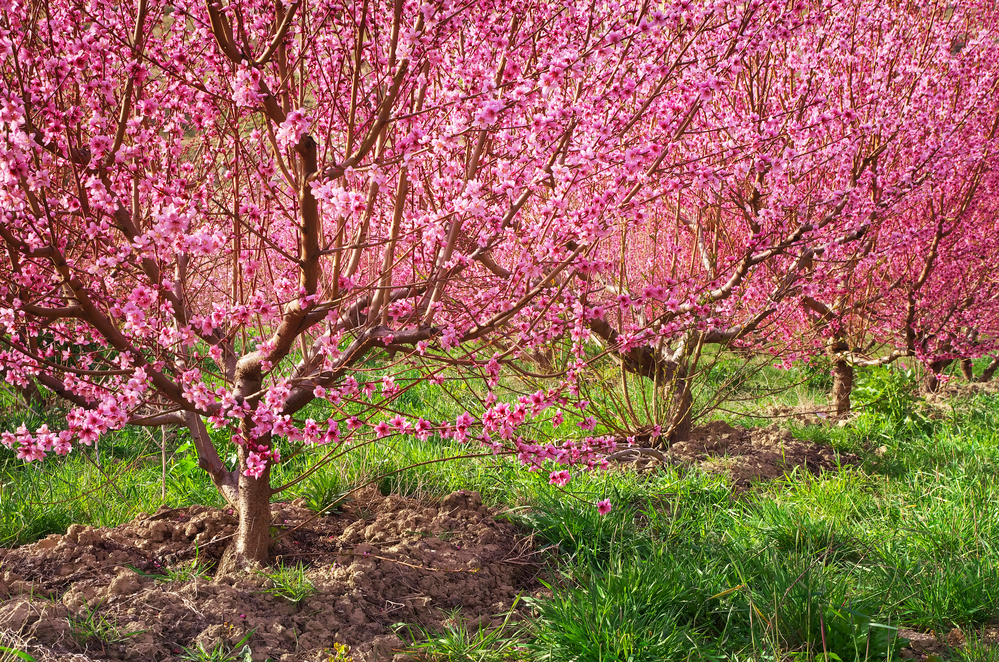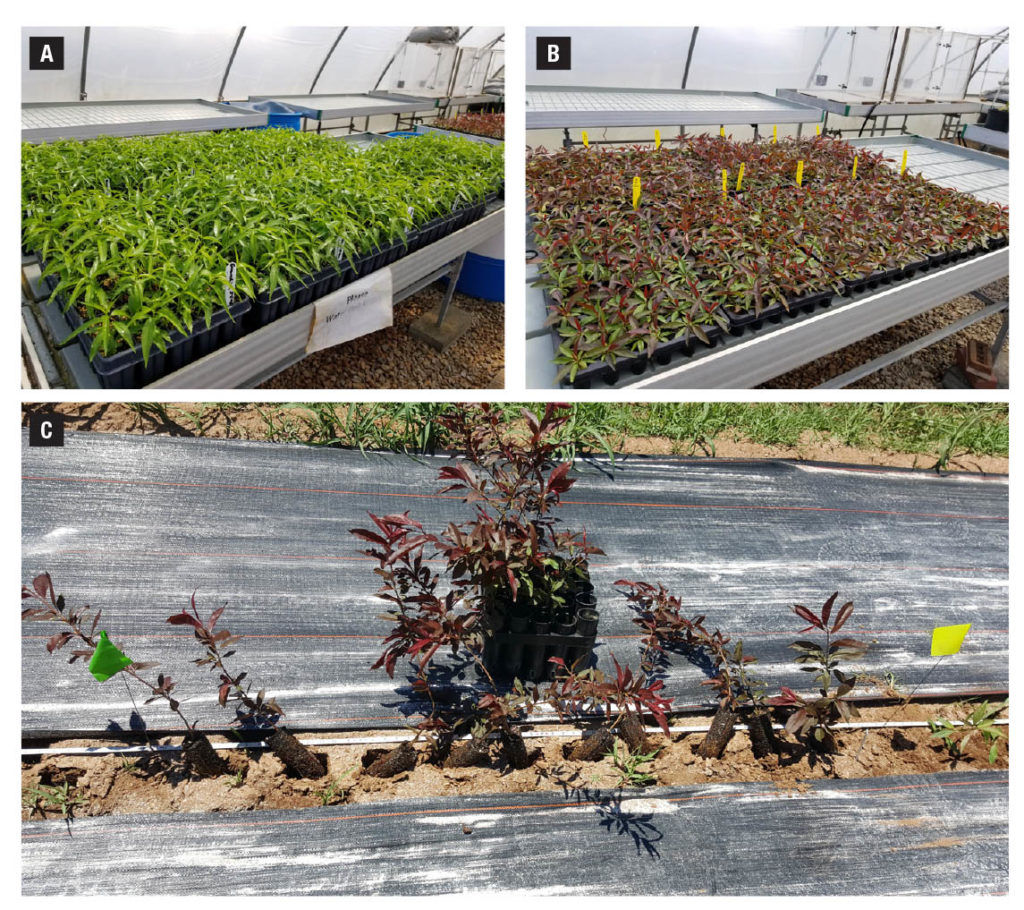By Dario J. Chavez, Jeff Cook and Tom G. Beckman
Rootstocks are important for fruit production as they provide required protection for soil pests and pathogens. The most predominant peach rootstocks in the Southeastern United States are Guardian (Alabama, Georgia and South Carolina) and Flordaguard (Florida). Guardian (BY520-9) was released by the U.S. Department of Agriculture Agricultural Research Service (USDA ARS) and Clemson University in 1993 to address issues with peach tree short life (PTSL) and resistance to Meloidogyne javanica and M. incognita nematodes. Flordaguard was released by the University of Florida in 1990 to address issues with M. floridensis, M. arenaria and M. javanica nematodes.

CURRENT SITUATION
Guardian peach rootstock is highly susceptible to Armillaria root rot (ARR) and is susceptible to M. floridensis. This nematode was recently reported in California, Georgia (believed to be present) and South Carolina and is endemic in Florida. After PTSL losses were addressed by using Guardian, losses due to ARR started to increase. Currently, ARR is the most devastating disease for peaches in the southeastern United States. Losses can mount to 50% by year five of establishment in soils highly infested with ARR.
MP-29, a clonal plum x peach hybrid, was released in 2011 by the USDA ARS and the University of Florida to address the need for a rootstock resistant to PTSL, nematodes (including M. floridensis) and ARR. MP-29 produces a remarkable reduction in vigor (~ 40 to 60% reduction in size in comparison to standard peach rootstocks such as Guardian and Lovell).
Budded plants on MP-29 are currently produced by commercial nurseries in a two-year cycle with the first year used for clonal propagation of the rootstock and the second year for budding/growth of the scion. Its propagation is different from the traditional one-year cycle with seed-propagated rootstocks (i.e., Guardian). This has limited the commercial availability of plants propagated on MP-29.

NURSERY RESEARCH
Research at the Peach Research and Extension Program at the University of Georgia (UGA) in 2017 and 2018 in collaboration with UGA Extension and USDA-ARS has been conducted to optimize the nursery production and propagation of plants budded onto MP-29 rootstock. In this research, Guardian seed-propagated seedlings (Figure 1A) were compared to two sources of MP-29 rootstock, tissue culture (TC, Figure 1B) and vegetative propagated [rooted cuttings (RC), Figure 1C] plantlets.
The study was divided into three parts. The first two parts were set up in an open field mimicking commercial nursery conditions. The third part was conducted in containers as an alternative production scheme. In all these experiments, the objective was to test the viability of TC plantlets to fit a one-year production cycle comparable to seed-propagated rootstocks. The goal was to provide the nursery industry with an alternative option to increase plants budded onto MP-29 every cycle.
TC-MP-29 plantlets were available in early April and were planted immediately together with the RC-MP-29 plantlets and Guardian seedlings. TC-MP-29 plantlets proved to be adaptable to a one-year propagation cycle in all the experiments. Approximately 86.3 to 100% of TC-MP-29 plantlets reached standard budding size (caliper) comparable to 96 to 100% of RC-MP-29 and 100% of Guardian by the time of budding.
Guardian rootstock caliper at budding was generally larger than RC-MP-29 and TC-MP-29 in all the experiments. Plant survival after budding ranged from 30 to 100%, in which Guardian seedlings had the highest survival after budding (70 to 100%). TC-MP-29 plantlets have the second highest plant survival after budding of 42.5 to 100%. Finally, RC-MP-29 plantlets had the lowest plant survival rate after budding of 30 to 67.5%.
The most optimal conditions for plant survival after budding, independent of the plantlet type, were obtained in the containerized experiment, in which survival of plants after budding was 100% for all types. All plants were T-budded with two scions (scions differed between experiments).
Budding success at the end of the experiments ranged from 29.4 to 84.5%. Guardian seedlings had the highest budding success of 67.5 to 84.5%, followed by TC-MP-29 plantlets with a budding success of 40.7 to 64.2%. RC-MP-29 plantlets had a budding success rate of 29.4 to 56.3%. Overall, RC-MP-29 had the lowest survival rate after budding and budding success rate across all the materials used. TC-MP-29 plantlets were comparable statistically to the survival and budding success observed with Guardian seedlings. At the end of the study in late fall, the caliper and height of the budded scion growing onto MP-29 tissue culture and rooted cuttings materials were not statistically different than that of Guardian seedlings.

FINAL REMARKS
The use of tissue culture plantlets of MP-29 rootstock proved to be beneficial in a one-year propagation cycle. A reduced budding success was observed across all the experiments when using MP-29 rootstock in comparison with Guardian. In addition, a containerized system can be a viable option for propagation of MP-29 finished plants and achieved higher survival of plantlets after planting.
The use of tissue culture plantlets for rootstock propagation is currently widely used in other fruit production systems such as apples. Its costs are relatively higher in comparison with rooted cuttings. Currently, nursery production for peach plants onto MP-29 is still mostly based on rooted cuttings. However, the use of tissue culture plants may need further consideration to increase the availability of plants in the market.
The current need by the Southeastern U.S. industry for finished plants of MP-29 is high due to ARR losses. Price of finished plants using tissue culture plantlets more likely will be higher in comparison to traditionally propagated plants onto peach rootstock seedlings such as Guardian and Lovell. The use of tissue culture plantlets may require modifications in the standard production scheme to obtain the required growth for budding. This may mean the use of plastic mulches, fertigation and row covers (for freeze protection).
Dario J. Chavez is an associate professor at the UGA in Griffin. Jeff Cook is a county Extension coordinator for UGA Extension. Tom G. Beckman is a retired stone fruit rootstock breeder at the Southeastern Fruit and Tree Nut Research Laboratory, USDA ARS in Byron, GA.












